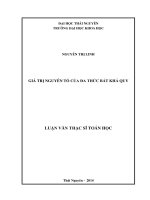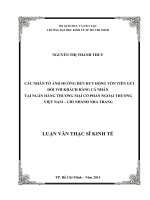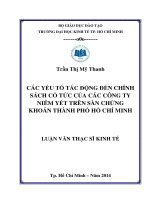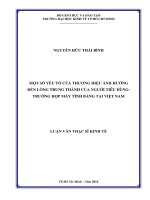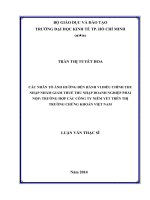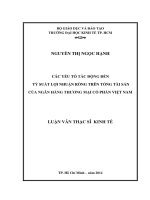(Luận văn thạc sĩ) factors affecting intention to subscribe SVOD in vietnam
Bạn đang xem bản rút gọn của tài liệu. Xem và tải ngay bản đầy đủ của tài liệu tại đây (2.14 MB, 96 trang )
VIETNAMxNATIONALxUNIVERSITY, HANOI
VIETNAMxJAPANxUNIVERSITY
---------------------------
LE PHU KHANH
FACTORS AFFECTING INTENTION TO
SUBSCRIBE TO SUBSCRIPTION VIDEO
ON DEMAND SERVICES INxVIETNAM
MASTER’S THESISx
Hanoi, 2020
VIETNAMxNATIONALxUNIVERSITY, HANOI
VIETNAMxJAPANxUNIVERSITY
---------------------------
LE PHU KHANH
FACTORS AFFECTING INTENTION TO
SUBSCRIBE TO SUBSCRIPTION VIDEO
ON DEMAND SERVICES INxVIETNAM
MAJOR:xBUSINESS ADMINSTRATION
CODE:x8340101.01
RESEARCHxSUPERVISORS:
Prof. Dr. MOTONARI TANABU
Dr. TRAN HUY PHUONG
Hanoi, 2020
ACKNOWLEDGMENT
First of all, I would like to give my thanks to Prof.Dr. Montonari Tanabu and
Doctor Tran Huy Phuong for helping and give me a lot of valuable advice
during the time I was conducting this master thesis.
Second, I would like to thank Prof. Matsui, Hanh sensei, Hino sensei, Tuan
sensei for giving me comments to improve my thesis on internal defense on
20th May. Moreover, I would like to thank the reviewers, including Prof.
Matsui, Prof.Morita, Hanh sensei. Tuan sensei, Lien sensei for giving me
comments on final defense on 24th June.
In addition, I would like to give many thanks to my family, who has
supported me and motivated me a lot in the time I got difficult in doing the
thesis.
Finally, I would like to give many thanks to my friends, the participants who
have supported me to complete the survey
Table of Content
ACKNOWLEDGMENT
LIST OF TABLES
LIST OF FIGURES
LIST OF ABBREVIATION
CHAPTER 1: INTRODUCTION ................................................................................. 1
1.1
Research Background ......................................................................................... 1
1.2
Research Objective ............................................................................................. 4
1.3
Research Question .............................................................................................. 4
1.3
Research Subjective and Research Scope .......................................................... 4
1.4
Research Contribution ........................................................................................ 4
CHAPTER 2: LITERATURE REVIEW AND HYPOTHESIS
DEVELOPMENT .......................................................................................................... 6
2.1 Review of related definition and previous research ............................................... 6
2.1.1 Definition of OTT platform............................................................................... 6
2.1.2 Definition of Streaming .................................................................................... 6
2.1.3 Definition of Video on demand (VOD) ............................................................. 7
2.1.4 Definition of Subscription Video on demand (SVOD) ..................................... 8
2.1.5 Related research & research gap ..................................................................... 9
2.2 Review of the relevant theoretical model of technology adoption: ...................... 14
2.2.1 Theory of reasoned action (TRA) ................................................................... 14
2.2.2 Theory of planned behavior (TPB)................................................................. 15
2.2.3 Technology acceptance model (TAM) ............................................................ 15
2.2.4 Unified theory of acceptance and use of technology (UTAUT) ..................... 16
2.2.5 Reason why the author choosing UTUAT2 as theoretical framework ........... 18
2.3 Hypothesis development and conceptual model .................................................. 18
2.3.1. Performance Expectancy ............................................................................... 19
2.3.2. Effort Expectancy .......................................................................................... 20
2.3.3. Social Influences............................................................................................ 21
2.3.4. Hedonic Motivation ....................................................................................... 21
2.3.5. Price Value .................................................................................................... 22
2.3.6. Facilitating condition .................................................................................... 23
2.3.7. Consumer Innovativeness .............................................................................. 23
2.3.8. Media exposure ............................................................................................. 24
2.4 Research conceptual model .................................................................................. 27
CHAPTER 3: METHODOLOGY .............................................................................. 28
3.1. Research process .................................................................................................. 28
3.2. Sampling and data collection ............................................................................... 29
3.3. Sample Population ............................................................................................... 29
3.4. Variable and Measuring Instrument .................................................................... 29
3.5. Analysis Method .................................................................................................. 32
3.5.1 Descriptive analysis ....................................................................................... 32
3.5.2 Inferential analysis ......................................................................................... 33
CHAPTER 4: ANALYSIS RESULTS ....................................................................... 36
4.1
Data Description ............................................................................................... 36
4.2
Reliability analysis ........................................................................................... 38
4.2.
Explanatory Factor Analysis ............................................................................ 38
4.3.1
Explanatory Analysis for independent variable ........................................ 38
4.3.2
Explanatory Analysis for dependent variable............................................ 40
4.3.3
Explanatory Analysis for moderation variable.......................................... 40
4.3.
Regression Analysis ......................................................................................... 41
4.4.
Moderation Analysis......................................................................................... 42
4.5
Hypothesis tested results .................................................................................. 44
CHAPTER 5: DISCUSSION AND CONCLUSION................................................. 46
5.1. Finding and Discussion........................................................................................ 46
5.2. Contribution of the thesis..................................................................................... 50
5.3. Implications for SVOD service providers ........................................................... 50
5.4. Limitation and future research direction.............................................................. 52
REFERENCES ............................................................................................................. 54
APPENDIX 1: Questionnaire...................................................................................... 65
APPENDIX 2: Cronbach’s alpha analysis................................................................. 75
APPENDIX 3: Explanatory Analysis ......................................................................... 80
APPENDIX 4: Pearson Correlation Analysis ........................................................... 84
APPENDIX 5: Regression analysis ............................................................................ 85
APPENDIX 6: Moderation Analysis .......................................................................... 86
LIST OF TABLES
Table 2.1: Construct's definition ...................................................................................... 19
Table 3.1: Measurement Scale of thesis ........................................................................... 30
Table 4.1: Cronbach’s alpha for all variable .................................................................... 38
Table 4.2: EFA Results for Independent variable ............................................................ 39
Table 4.3: EFA Results for Dependent Variable ............................................................. 40
Table 4.4: EFA Results for Moderator ............................................................................. 40
Table 4.5: Results of Pearson Analysis ............................................................................ 41
Table 4.6: Results of regression analysis ......................................................................... 41
Table 4.7: Moderation analysis by Hayes ........................................................................ 43
i
LIST OF FIGURES
Figure 2.1: Results study of Cerbeci et al (2019) ........................................................... 9
Figure 2.2: Results study of Ramírez-Corre et al (2018) .............................................. 10
Figure 2.3: Research results of Sardanelli et al (2019) ................................................. 11
Figure 2.4: Theory of reasoned action (Fishbein & Ajzen, 1975) ................................ 14
Figure 2.5: Theory of planned behavior (Ajzen, 1991) ................................................ 15
Figure 2.6: Technology acceptance model (Davis, 1989) ............................................ 16
Figure 2.7: Unified theory of acceptance and use of technology UTAUT
(Venkatesh et al., 2003) ................................................................................................. 17
Figure 2.8: Unified theory of acceptance and use of technology UTAUT2
(Venkatesh et al., 2012) ................................................................................................. 18
Figure 3.1: Research Model Proposed by Author ......................................................... 27
Figure 4.1: Age group of respondences ........................................................................ 27
Figure 4.2: Descriptive data of current users ................................................................ 37
Figure 4.3: Descriptive data of SVOD references channel ........................................... 37
ii
LIST OF ABBREVIATION
OTT
Over-the-top
SVOD
Subscription Video on demand
TAM
Technology Acceptance Model
TPB
Theory of Planned Behavior
TRA
Theory of Reasoned Action
UTAUT
Unified Theory of acceptance and use
of technology
UTAUT2
Extended Unified Theory of
acceptance and use of technology
VOD
Video on demand
iii
CHAPTER 1: INTRODUCTION
1.1 Research Background
Today, thanks to the advancement of technology, people have changed the way
they consume media (Shim & Kim, 2018). The development of Broadband Internet
paved the way for the multimedia industry to shift from traditional Cable TV to
OTT Streaming (Over-the-top Streaming). OTT is superior to the traditional Cable
TV because of 2 characteristics: mobility and internet (Kim et al., 2016). Thus, OTT
streaming has become the technology preferred by consumers to entertain (Shim et
al., 2018). OTT streaming is well-known for its service called Subscription video on
demand (SVOD).
During 2010, the SVOD market was still in the early stage, with the domination
of Netflix. However, in 2019, there were a lot of big players joining the SVOD
industry, such as Apple, Disney, and WarnerMedia, which pave a new era for the
SVOD market known as the name “Streaming Wars” (Ben, 2019). The predict of
Pwc Global Entertainment and Media Outlook report showed that the size of this
market will be doubling up to $72.8 billion. Other results showed that in 2018,
traditional cable TV firms had less than 3 million users, while SVOD services
revenue increased from 30 billion USD by 2016 to 68 billion USD by 2018 (Yen,
2019).
Despite the success of SVOD in the world, the number of people using this
service is still limited in Vietnam. According to the figure of Authority of
Broadcasting and Electronic Information in 2020, the number of users of the whole
SVOD market in Vietnam was 10 million users, which accounts for only 10%
market penetration (VTV, 2020). Even the big firm in this industry like Netflix,
which has 130 million subscribers in the world (Louis, 2018), is having a low
number of users in Vietnam. According to ictnew.vn, the number of Netflix
subscribers in Vietnam was only 300.000 users, which accounts for just only about
0.31% of the total Vietnamese population (Minh, 2019). Despite the low adoption
1
level, there still positive evidence showing that this industry has the potential to
grow in Vietnam. By the analysis of Statista.com in 7/2019, there are more than
54% of Vietnamese frequently using the Internet, and these people will increase by
38% in 2023. Also, another figure showed that Vietnam users spend 6-7 hours each
day using the Internet, mainly for entertaining (Statista, 2020). In Vietnam, there are
36 SVOD firms. The foreign firms in this industry are Netflix, Apple TV,.. and the
most famous Vietnamese firms in this industry are ClipTV, FPT play. VTVcab ON,
VTC Now, My K+ NOW,… .The revenue growth of the SVOD industry in
Vietnam is predicted by up to 113% by 2023 (Statista, 2020). Many foreign SVOD
companies are interested in this market. For example, the leader of Netflix – one of
the big firms in the SVOD industry had a meeting with the Head of the Government
Office to make an agreement about entering Vietnam in November 2019 officially
(Luu, 2019). This evidence shows that Vietnam is a potential as well as high
competition for exploit such online entertainment services like SVOD.
For an industry that started to grow like SVOD in Vietnam, since the number of
SVOD users in Vietnam was still limited, the finding of consumer insight and user’s
psychology in subscription intention to SVOD is necessary.
Recently, the number of studies on SVOD is really limited. In previous studies,
some key factors had been proved to have an impact on subscription intention. The
most common factors were perceived usefulness and perceived ease of use (Cebeci
et al., 2019; Ramíez-Correa et al., 2017; Sardanelli et al., 2019; Lee et al. 2018). For
instance, Cebeci et al (2019) using Technology Acceptance Model (TAM), found
out that a person who had the perception of usefulness would have the intention to
use Netflix in the context of Istanbul, other remaining factors in Cebeci’s study are
Perceived Ease of Use, Knowledge and Technology Anxiety. In addition, RamíezCorrea et al. (2017) found that a person who had a high enjoyment perception of
Netflix would highly have the behavioral intention of using Netflix. Some other
scholars approached at the angle of movie piracy, which concluded that Moral
Judgement and Product Involvement were the two key factors which affecting
2
subscription intention of movie streaming service by using TPB as a based model
(Sardanelli et al., 2019). Although studies about SVOD investigated the
subscription intention from different angles, there still theoretical gaps that needs to
be filled. First, to the best of the author’s knowledge, most studies were looking at
one company (in this case, Netflix) rather than identify factors affecting behavior
intention for a whole industry like SVOD, especially in Vietnam. Second, there is a
lack of research applied UTAUT2 to the domain-specific case like SVOD industries.
Finally, previous studies were focusing on piracy, technology, finance factors.
There was a lack of factors related to mass media as well as factors related to
consumer’s traits to the behavioral intention of SVOD users.
About UTUAT2, this model was the latest one in technology adoption.
Venkatesh et al. (2012) mentioned adding moderator as the way to expand the
theory of UTAUT2. Following Vankatesh’s suggestion, many tried to test the role
of Age, Gender, Personalization,… as a moderator to UTAUT2. But to the best of
the author, there is no research added Media Exposure to UTAUT2 as a moderator.
There is reason to prove that Media Exposure can have a moderating effect. The
fact that consumers made their decision based on the information they gained. The
amount of information from media exposure can affect the cognitive function of a
person (Christakis et al. 2018). According to DeFleur, Melvin, and Everett Dennis
(1998), enough frequency of media exposure could change one person’s behavior
and belief. Because of that, Media Exposure can be treated as a moderator. The
thesis will test the role of Media Exposure whether it has a moderating effect on the
UTAUT2 construct.
In conclusion, based on theoretical and practical motivation, the author conducts
study names “Factors affecting intention to subscribe to SVOD services in Vietnam”
as an MBA thesis topic.
3
1.2 Research Objective
There is a lack of research applied UTAUT2 to understand consumer’s intention
to subscribe to SVOD. Therefore, this thesis will test UTAUT2 in the SVOD
context as empirical evidence contributes to the SVOD studies.
The thesis also tests the role of Consumer Innovativeness and moderating effect
of Media exposure to the UTAUT2 model to expand the approach of Media
exposure as moderators and contribute to the theory of UTAUT2.
1.3 Research Question
Based on the research motivation, both theoretical and practical, this study
answers the following question:
1. What are the factors that significantly influence users’ adoption of Subscription
video on demand in Vietnam?
2. Can Media Exposure moderate the relationship between the independent variable
and subscription intention of SVOD in Vietnam?
1.4 Research Subjective and Research Scope
-
Research Subjective
The subject of the research will be “Factors affecting intention to subscribe to
SVOD of Vietnamese people who already have acknowledged about this service”.
-
Research Scope
The scope of thisxstudyxwill mainly in Hanoi because they have a huge amount
of people in general and have already aware of SVOD service. This study will have
a time range from 2019 to 2020.
1.5.Research Contribution
-
Theoretical contribution
4
The thesis applied UTUAT2 since there is no literature of SVOD applied
UTAUT2 in the SVOD context, especially in Vietnam there has no study related to
subscription video on demand.
The study also confirmed the previous finding of Consumer Innovativeness on
intention behavior in SVOD context.
The study also found the
Moderating effect of Mediaxexposurexon
thexrelationship between Hedonic Motivation and Intention Behaviors. The finding
contributed to the UTAUT2 theory because this is the early study that investigates
the moderating role of media exposure to UTAUT2.
-
Practical contribution
The thesis had proposed several solutions to increase the number of subscribers for
SVOD service providers.
5
CHAPTER 2: LITERATURE
DEVELOPMENT
REVIEW
AND
HYPOTHESIS
2.1 Review of related definition and previous research
2.1.1 Definition of OTT platform
According to the Ministry of Information and Communication of Vietnam
(MIC, 2019), Over-the-top (OTT) platform is the media service that uses the
internet to transfer content and added values to consumers. OTT platform provides
content directly to the Internet rather than provides under the management of any
Internet Service Provider. Thus, it paves a way for OTT platform users to access
content on many different devices. Another feature of OTT is the recommendation
system that supports users to find content that they needed easily.
There are three types of OTT services. The first one is OTT television,
usually
called
streaming
video.
The
example
for
this
type
are
subscriptionxvideoxonxdemand (SVOD) firms such as Netflix, Amazon Prime,
Hulu, … The second types of OTT are OTT messaging/voice calling services. OTT
messaging/voice calling can be defined as an instant messaging/ voice calling
service provided by the third party as an alternative to traditional SMS. The most
well-known brand for these types is WeChat, Skype, Viber, Zalo,... The final types
of OTT platform types are OTT music, known as music streaming. Examples of
these types are Spotify and YouTube Music (Technavio, 2019). This study will only
be focusing on the first types of OTT, which is video streaming.
2.1.2 Definition of Streaming
According to Oxford Dictionaries, Streaming is a method of sending or
receiving data (video and audio material) through the internet in a continuous
stream (Oxford University Press, 2019). Streaming is similar to the television
broadcast, the only difference is that streaming delivers content through the internet
6
(Austerberry, 2005). In a television broadcast, content is pushed to the user on a
certain schedule.
With streaming, users can choose content, generally through interaction with
the web provider's service. There are three ways to transmit multimedia content,
listed below:
a. Download
Content can be played by users after they have downloaded from the severs.
The multimedia file received will be stored on computer storage media. After
received the multimedia file successfully on the user’s side, the user can
access the content.
b. Progressive Download
Progressive download is defined as the media that can be played a few
seconds after the download process begins. Progressive download is similar
to streaming, but the media in this type still through the process of
downloading, or other terms called pseudo streaming.
c. Streaming
The media can be played directly without going through the download
process. Through this transmission process, parts of the media are received
on the user’s side can be played immediately.
Based on the above definition, it can be concluded that streaming is a method of
transferring content to the user via the web in real-time and can be watched without
having to wait for downloaded.
2.1.3 Definition of Video on demand (VOD)
According to the research of Chen with his collaboration (2014), video on
demand (VOD) can be understood as a system that allows users to be able to choose
and watch videos that they want regardless of time and place. The VOD system can
enable users to gain control over the media they watch.
7
Until now, there are many videos on-demand services on the internet which
provide free video content such as Youtube, Vimeo, Dailymotion, and others. Users
of the service can enjoy content videos that have been uploaded by creators from
various fields, such as food, beauty, automotive, music, film, technology, and so on.
Based on the above definition, it can be concluded that the video on demand
is a system for watching video shows in a manner interactive where users can freely
choose the content and be able to control the content.
2.1.4 Definition of Subscription Video on demand (SVOD)
Subscriptionxvideoxonxdemand (SVOD) is defined as a service where users
are charged a subcription fee (generally per month) to be able to choose and enjoy
content freely provided by the SVOD service providers at any time and anywhere as
long as users are connected to the internet (Wayne, 2018). By using OTT
technology, SVOD services can have the ability to help users search for
entertainment content easily with the help of a recommendation system using A.I
and Big Data (Xavier, 2013).
SVOD is also defined as an online entertainment service where users are
charged monthly to access to a streaming library consisting of films, television
shows and other media content (Stastista, 2019a)
In the world such as Netflix, ESPN+, Hulu, and Vietnam such as FPT Play,
K+ Now, Clip TV are some examples of SVOD technology. The number of SVOD
users in the whole world is going up rapidly from around 283 million users a year
by 2018 to 411 million users by 2022. The younger generation is the one who
spends most of the time using SVOD, with users aged 18-24 years spend an average
ofx39 minutes per day using SVOD services (Stastista, 2019a)
Based on the above definition, it can be concluded that the subscription video
on demand is a service provided content such as films, television series,
documentaries. SVOD service providers require a monthly subscription fee, after
paying the fee users can access SVOD’s content anywhere and at any time. One of
8
the remarkable features of OTT in general as well as SVOD comes from a
recommendation system that helps users find their entertainment content faster.
2.1.5 Related research & research gap
Related Research
Recently, there are a few authors have mentioned about subscription
intention of SVOD. The detail of each research is mention at the following:
Cebeci et al. (2019) were one of the pioneer studies in SVOD with the topic
“Understanding the Intention to Use Netflix: An Extended Technology Acceptance
Model Approach”. UsedxTAMxasxa based theoretical framework on Istanbul
context, the study found out Attitude had a direct effect on the intention to use,
Perceived Usefulness influenced attitudes, support by the moderating effect of
technology
anxiety,
Knowledge
andxPerceivedxUsefulness,
affected
Self-efficacy
had
both
a
PerceivexEasexofxUse
positive
effect
on
PerceivedxEase ofxUse.
x
Figure 2.1: Results study of Cerbeci et al (2019)
Cerbeci and his team succeeded in building a comprehensive model
predicting intention to subscribe to Netflix. However, the study still had some
limitations. First, this study conducted only in Istanbul, so the generalizability of the
finding is still a constraint. Second, the factors mentioned are mostly looking at the
aspect of technology. In reality, subscription intention can be affected by other
factors such as Price, Perceived Quality,...
9
Another scholar - Ramírez-Corre with his partners (2018) conducted a topic
name “The acceptance of Netflix: a study using structural equations” to investigate
customer intention of using Netflix in Brazil. The study followed quantitative
analysis using TAM for the hedonic information system suggest by Heijden (2004).
The result found out that Perceived Usefulness, Perceived Ease of Use, Perceived
Enjoyment have a positive relationship with behavior intention, moderating by
Experiences.
Figure 2.2: Results study of Ramírez-Corre et al (2018)
The study has confirmed one of the major findings of Heijden (2004),
augured the importance of two factors about the perception of useful and easy to use,
which came from the TAM model. Ramirez mentioned that under the context of the
hedonic information system, the role of Perceived Enjoyment is more important
than the remaining factors. The limitation of the research is that Ramirez-Corre just
only focusing on four factors: PerceivedxUsefulness, Perceived Ease ofxUse,
x
Perceived Enjoyment, and Experience.
The study of Lee et al (2018) name “Factors Affecting Online Streaming
Subscriptions” investigated the switching intention of consumers from traditional
TV to online streaming service by compared between traditional TV users and
online streaming users. The results found only Social Trend, Media Option, and
Age had significant on subscription intention behavior of online streaming. The
10
sample of study still had some limitations while the majority of respondence mostly
from young as 18 to older as 34 age range, which the results tend to represent for
young users.
A qualitative analysis study had been conducted by Dasgupta and Grover
(2019) with the topic “Understanding Adoption Factors Of Over-The-Top Video
Services Among Millennial Consumers in India”. The study found the most
important feature which leads to the adoption of OTT video service is Convenience,
Content, Mobility, Cost. The research did not have a high generalizability level
since it was conducted only in two cities of India. Also, OTT service is a nascent
concept in India, so the finding may not fully understand the insight of consumers
toward OTT video services.
Sardanelli et al (2019) investigated the intention to subscribe to movie
streaming services in Italy from the perspective of illegal downloading using TPB.
The study included variables such as Product Involvement (INV), Subjective Norm
(SN), Frequency of Past Behaviour (FNB), Moral Judgement (MORAL), Perceived
Risk (RISK), Attitude (ATT). The study found out that attitude, frequency of past
behavior, and involvement have an important role in explaining the subscription
intention of movie streaming services.
Figure 2.3: Research results of Sardanelli et al (2019)
The study still has some drawbacks such as limited sample and the level of digital
privacy in Italy is still high. Longitudinal research was suggested in future studies.
11
Research Gap
Overall, in terms of SVOD previous study, some factors had been agreed to
have affected intention to subscribe SVOD or video streaming services such as
Perceived Usefulness, Perceived Enjoyment, Perceived Ease of Use, Experience,
Knowledge, Content, Cost, Mobility, Convenience, Attitude, Moral Judgement,
Perceived Risk, Media Option and Social Trend. However, those factors were only
focusing on technology and finance aspects. There is a lack of concern about factors
in the aspect of media promotion and the factors related to consumer trait to the
intention to subscribe to SVOD. Moreover, to the best of the researcher’s
knowledge, there is no research applied UTUAT2 to the context of SVOD.
Therefore, the following study will add Media Exposure to Advertising
SVOD message as media promotion aspect and Consumer Innovativeness as
consumer trait aspect to have a deep understanding of factors affecting the intention
to subscribe to SVOD.
Media exposure to SVOD advertisement as moderator:
During 2010, in SVOD industry, Netflix was the only firm that provided this
service, so media and advertising were not quite important as there is no competitor.
However, recently, due to the intense competition between SVOD platform, media
and advertising can be an important factor that contributes to the success of a firm
in this industry. There are some reasons which prove that media is important for
intention behavior. First, usually, consumers made their decision based on the
information they gained. The amount of information from media exposure can
affect the cognitive function of a person (Christakis, 2018). Second, DeFleur,
Melvin, and Everett Dennis (1998) state that repetition as well the consistency of
the media can change the behavior and belief of a person in the long-term. In the
case of SVOD, the repetition of advertising can provide information to the
audiences about the characteristic of the technology, thus change the way they
expect about the easy and useful of technology and the way they think about the
12
value price of the services. Or in another word, media exposure to SVOD
advertising can strengthenxthexrelationship between the dependent variables and
behavioral intention in UTAUT2.
In academic aspects, Media exposure had been tested in many different
approaches. A. Qader (2011) proved that media exposure can have a direct impact
on behavioral intention. Other scholars also had the same results (Lee, Koo, &
Chung, 2019; Khofanda & Fajarindra Belgiawan, 2018). Some scholars found the
media exposure can have a direct impact on human perception (Li X., 2018; Wang,
Guo, & Shen, 2011). Media exposure in some case can help to influent brand-recall
and purchasing intention (Turley & Shannon, 2000; Sohail & Sana, 2011;
Muhammad & Tanveer, 2015) as well as can be initial preparation for the stage of
the consumer’s decision-making process (Burton et al, 2019). However, recently,
there is a lack of study that tested the moderating role of Media Exposure to the
relationship between human perception and behavioral intention, although some
researchers have suggested this approach. Reynaldo A.Baustista Jr (2017) in the
research of the generic drug, suggested the role of media exposure in strengthening
the relationship between TPB construct and behavioral intention. Another study also
suggested about moderating role of Media Exposure, in this case, Media Exposure
can strengthen the relationship between buying attitude and perception of value (Jan,
Ji, & Yeo, 2019). Therefore, it is a good opportunity to test whether media exposure
can strengthen the relationship between UTAUT2 constructs and behavioral
intention.
Consumer Innovativeness as additional variables related to consumer’s trait.
In many studies about technology acceptance, many researchers tried to test
whether factors related to consumer’s traits can affect behavioral intention. For
example, Qing et al (2012) investigated whether consumer’s lifestyles can predict
the purchase intention of fresh fruit in China. The study found out that a person with
risk-taker and traditionalists traits was likely to have the intention to purchase fresh
fruit. Although there were many factors relating to consumer’s trait had been
13
explored by previous researchers, some of them were still not been explored
carefully. One of them was Consumer Innovative which proposed by Roger (1983)
in his book called “Diffusion of Innovation”. Some scholars in the domain of
marketing also mentioned this factor (Migley & Downling, 1978; Agarwal &
Prasad, 1988; Flynn & Goldsmith, 1993). Consumer Innovative was defined as “the
willingness of an individual to try out any new information technology.” (Agarwal
& Prasad, 1988). In other words, a person who has open-minded to newness has a
high possibility to accept a technology faster than others as well as more likely to
influent others to adopt new technology (Roger, 1983).
On many studies about Consumer Innovativeness, there had been
inconsistent in the results of Consumer Innovativeness to Intention Behaviour.
Some studies proved there was a relationship between these 2 variables (Goldsmith,
2000; Ho & Wu, 2011; Foxall & Bhate, 1991; Paswan & Hirunyawipada, 2006).
However, some showed no relationship between them (Im et al., 2003; Chao et al.,
2012). Therefore, this study will investigate to what extent Consumer
Innovativeness impact Behaviour Intention in the context of SVOD in Vietnam.
2.2 Review of the relevant theoretical model of technology adoption:
2.2.1 Theory of reasoned action (TRA)
This theory explains the behavioral intention byxattitudextowardxbehavior
and subjective norm. The attitudes toward behavior is “the positive or negative of
an individual toward conducting a behavior to the subject” (Fishbein & Ajzen,
1975), and the subjective norm was defined as the feeling of others when we
conducting a behavior.
Figure 2.4: Theory of reasoned action (Fishbein & Ajzen, 1975)
14
The limitation of the Theory of Reason behaviors (TRA) is that this model
assumes a person’s cognitive decided his/her behaviors. Therefore, the theory of
Ajzen cannot explain consumer behaviors if an individual behaves based on his/her
habit or behaves unconsciously. Moreover, Ajzen just considered the relationship
between attitudes and behaviors of an individual itself rather than concerning the
social factors. In the reality, in some cases, social factors do have affect intention
behavior of an individual (Shiau et al., 2012; Rieke et al., 2016)
2.2.2 Theory of planned behavior (TPB)
The theory of plannedxbehavior is an expansion of TRA to enhance the
ability to explain behavior which not under control (Ajzen, 1991). The added
determinant in TRA is Perceived Behavioral Control.
Figure 2.5: Theory of planned behavior (Ajzen, 1991)
According to Aizen (1991): “The Perceived Behavioral control can trigger from
each person’s internal (Ability, Determination...) or external (Time, chance,…)”.
TPB model was considered as more complete than TRA in explaining consumer
behavior.
2.2.3 Technology acceptance model (TAM)
In the studies about technology adoption, some scholars have emphasized the
relationshipxbetweenxattitudexandxintention behavior. Davis (1989) developed TAM
to explain the behavior of consumers toward a specific technology, which
emphasized the relationship between attitudes toward technology and intention
15
behavior. TAM was adapted and developed based on the theoretical background of
TRA in constructing relationships among factors to explain human behaviors to
accept and use an Information System (Davis, 1989).
Figure 2.6: Technology acceptance model (Davis, 1989)
TAM explained usersxacceptance through 2 determinants, which were (1)
Perceived Usefulness and (2) Perceived ease of Use. In addition, in TAM, the
perception of a person who using Information technology can be influenced by
environmental factors such as experiences, knowledge, training level, and IT
process. Different from TRA, this theory emphasized the role of the self-making
decision of consumers during the time they consume products.
2.2.4 Unified theory of acceptance and use of technology (UTAUT)
To unify all factors relating to the adoption of technology in the field of
information system, UTAUT was proposed. The intention behaviors can be
explained by 4 key elements in this theory.
In previous studies, there were arguments that there is a similarity between
technology acceptance theories. Therefore, Venkatesh et al (2003) suggested it
would be better if someone can merge them into one unified theory. That is the
reason UTAUT has been made to support further study related to the acceptance
and used of technology.
16



